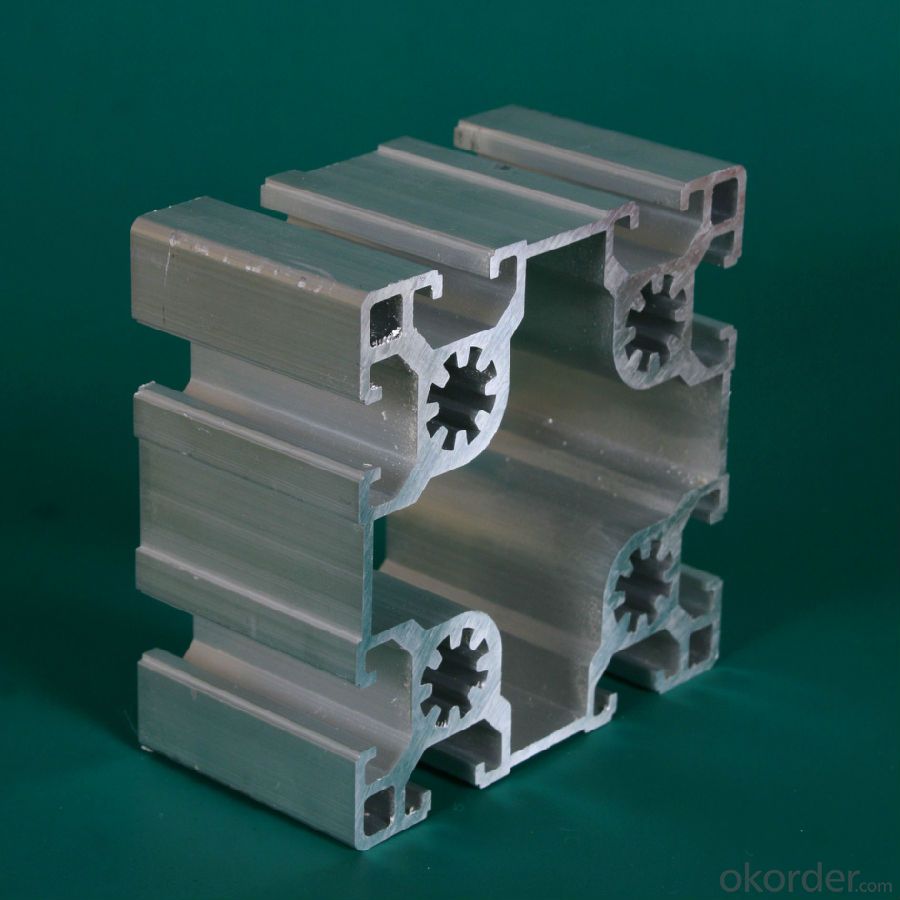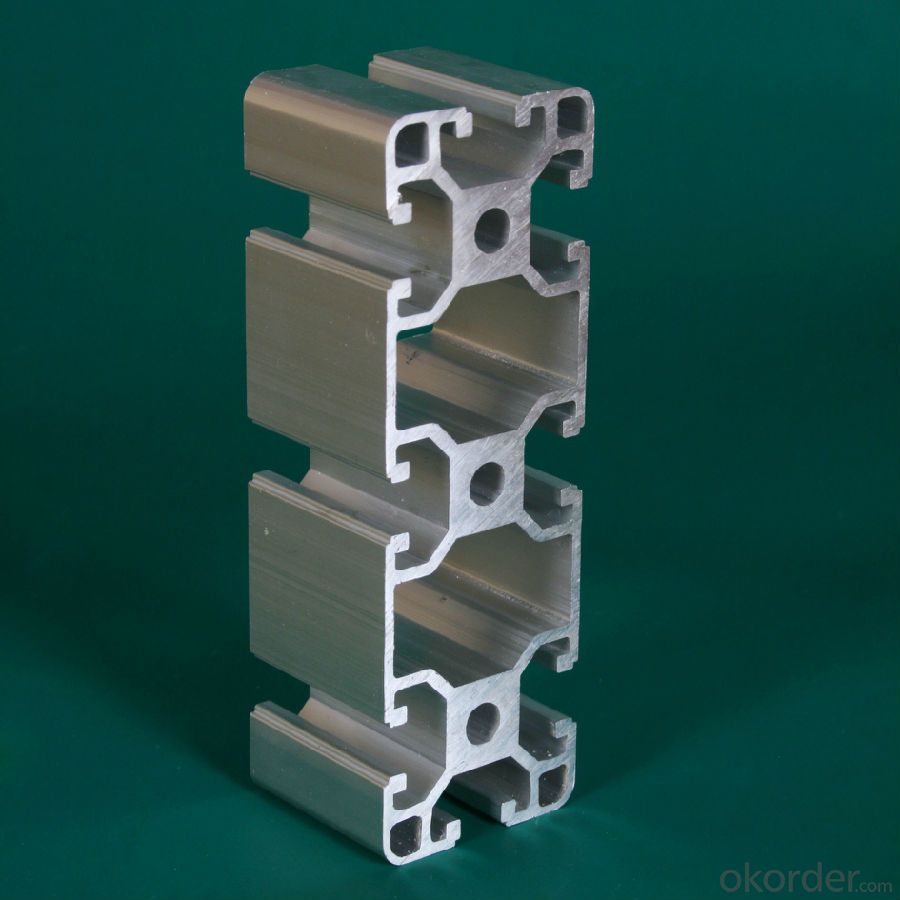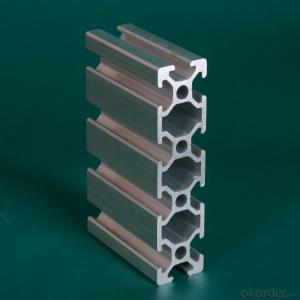Alloy 6005 Aluminium Extrusion Profiles For Industrial Application
- Loading Port:
- Qingdao
- Payment Terms:
- TT OR LC
- Min Order Qty:
- 2 m.t.
- Supply Capability:
- 50000 m.t./month
OKorder Service Pledge
OKorder Financial Service
You Might Also Like
Item specifice
Product Description
Product Name | Alloy 6005 Aluminium Extrusion Profiles For Industrial Application |
Alloy | Al 6063 T5 /T6 or 6061 T4/T6 or as customers' need |
Surface | Aluminum profiles of mill finish, powder coating, anodizing, polishing, sand blasting, electrophoresis and wood color. |
Profile shape | According to drawings or re-design as requested or market needs. |
Price | Based on Aluminum Ingot Price + Process fee |
Payment term | T/C T/T 30% deposit and 70% pay against copy of B/L |
Certificate | ISO9001 ISO14001 |
Warranty | 1. GB5237-2008 equal to EN12020-1.2(2001); 2. Within 15 years without powder peeling off; |


Product Advantages
1. Plenty of surface treatments for your choice, for example oxidation, electrophoresis and static powder coating, etc.
2. Strict control for surface finish, very little scratch.
3. Accurate mold as well as accurate size.
4. Standard alloy composition
5. Both ends of the profiles are very plain and with no burr.
FAQ
1. What is your main product?
We can supply the aluminium complete system, including aluminum billets, aluminum profile for windows and doors, aluminum for curtain wall, alumimun framwork, and kinds of aluminum windows and doors.
2. What’s your price?
The price is based on buyer's specific requirement, so please provide below information to help us quote exact price to you.
3. What is your payment term?
30% - 50% down payment, the balance payment against, and L/C is available.
- Q:How do aluminum profiles contribute to sustainable transportation solutions?
- Aluminum profiles contribute to sustainable transportation solutions in several ways. Firstly, aluminum is a lightweight material, which means it can help reduce the overall weight of vehicles. This, in turn, improves fuel efficiency and reduces carbon emissions. Additionally, aluminum profiles are highly durable and corrosion-resistant, leading to longer lifespan and reduced maintenance requirements. Furthermore, aluminum is recyclable, allowing for the reuse of the material in other applications, thus reducing the need for new production and minimizing waste. Overall, the use of aluminum profiles in transportation helps promote sustainability by improving fuel efficiency, reducing emissions, and minimizing resource consumption.
- Q:How do aluminum profiles perform in terms of sound insulation?
- Aluminum profiles generally have poor sound insulation properties compared to other materials such as wood or uPVC. This is because aluminum is a relatively lightweight and thin material, which allows sound waves to easily pass through it. Additionally, aluminum profiles often have a hollow structure, further reducing their ability to block or absorb sound. However, it is important to note that the overall sound insulation performance of a window or door system depends on various factors such as the thickness of the glass, the quality of the seals, and the installation method. To enhance the sound insulation capabilities of aluminum profiles, manufacturers may incorporate additional features like double or triple glazing, laminated glass, or acoustic seals. In conclusion, while aluminum profiles alone may not provide optimal sound insulation, they can be combined with other elements to improve their performance. If sound insulation is a significant concern, it is advisable to consider alternative materials that offer better inherent sound insulation properties.
- Q:Can aluminum profiles be used in the production of transportation containers?
- Indeed, the utilization of aluminum profiles is possible for the manufacturing of transportation containers. Aluminum, being a lightweight and long-lasting material, is widely employed in various industries, including transportation. It presents several advantages for container production, encompassing resistance to corrosion, a high strength-to-weight ratio, and effortless fabrication. By employing aluminum profiles, one can construct the framework and walls of transportation containers, which ensures structural integrity while maintaining a low overall weight. Moreover, aluminum profiles can be conveniently customized and shaped to meet specific container requirements. All in all, the incorporation of aluminum profiles in the production of transportation containers offers numerous benefits and is a favored choice among manufacturers.
- Q:How do aluminum profiles compare to other types of materials?
- Compared to other materials, aluminum profiles possess several advantages. Firstly, their lightweight nature is well-known, making them easier to handle and transport. This quality is particularly advantageous in industries where weight reduction is crucial, such as aerospace and automotive sectors. Secondly, aluminum profiles exhibit excellent resistance to corrosion. Unlike materials like steel or iron, aluminum does not rust when exposed to moisture or other corrosive elements. This makes aluminum profiles ideal for outdoor applications or in environments where moisture is present, such as marine or coastal areas. Furthermore, aluminum profiles have a high strength-to-weight ratio, meaning they are relatively strong while remaining lightweight. This attribute allows for the utilization of aluminum in various structural applications, where strength is important but weight reduction is also desired. Moreover, aluminum profiles are highly versatile and can be easily extruded into different shapes and sizes to meet specific design requirements. This flexibility permits customization and adaptability in various industries, including construction, transportation, and industrial manufacturing. Lastly, aluminum is an incredibly sustainable material. It is 100% recyclable, meaning it can be melted down and reused without any loss in quality. This contributes to the reduction of environmental impact and promotes a circular economy. In conclusion, aluminum profiles offer a combination of lightweight properties, corrosion resistance, strength, versatility, and sustainability, making them a favorable choice over other materials in numerous applications.
- Q:What are the different machining options for aluminum profiles?
- For aluminum profiles, there are various machining options to choose from, depending on specific requirements and desired outcomes. Some commonly used machining options for aluminum profiles include: 1. Milling: By utilizing rotating cutting tools, material can be removed from the aluminum profile, resulting in intricate shapes and features. This versatile option is suitable for both roughing and finishing tasks. 2. Drilling: Holes can be created in aluminum profiles through drilling. The precision and accuracy required determine whether a conventional drill or a CNC machine is used. 3. Tapping: To enable secure fastening, internal threads can be created in aluminum profiles through tapping. This is commonly used with screws or bolts. 4. Turning: By rotating the aluminum profile and applying a cutting tool, cylindrical shapes or features can be created through turning. This method is often employed for precise round components like shafts or pins. 5. Sawing: Aluminum profiles can be cut to specific lengths or straight cuts can be made using a saw blade. This process is known as sawing. 6. Bending: To achieve the desired form, force is applied to reshape the aluminum profile through bending. Various methods, such as press brakes or roll forming machines, can be utilized for this purpose. 7. Grinding: For a smooth, polished finish or to remove imperfections, grinding involves using abrasive particles to eliminate small amounts of material from the surface of the aluminum profile. 8. Welding: Joining aluminum profiles is commonly done through welding. This process involves melting and fusing the aluminum profiles together using heat and pressure, resulting in a strong and durable bond. These examples highlight the range of machining options available for aluminum profiles. The choice of machining method depends on factors such as the desired shape, size, finish, and specific application requirements of the profile.
- Q:What are the fireproofing properties of aluminum profiles?
- Aluminum profiles possess excellent fireproofing properties due to their high melting point, which is around 660 degrees Celsius. This allows them to withstand high temperatures and prevent the spread of fire. Moreover, aluminum does not burn or produce toxic gases when exposed to flames, making it a safe and reliable material for fireproofing applications.
- Q:What are the surface hardness properties of aluminum profiles?
- The surface hardness properties of aluminum profiles vary depending on the specific alloy and treatment. Generally, aluminum profiles have a moderate to high surface hardness, making them resistant to scratches and wear. However, compared to other metals like steel, aluminum has relatively lower hardness. To enhance the hardness, surface treatments such as anodizing or hard coat finishing can be applied, which significantly improve the wear resistance and durability of aluminum profiles.
- Q:What are the different surface protection options available for aluminum profiles?
- There are several surface protection options available for aluminum profiles, depending on the specific requirements and applications. 1. Anodizing: Anodizing is a commonly used surface treatment for aluminum profiles. It involves creating a protective oxide layer on the surface of the aluminum through an electrochemical process. Anodizing provides excellent corrosion resistance, durability, and can also enhance the aesthetic appearance of the profiles by offering a range of colors. 2. Powder Coating: Powder coating is another popular surface protection option for aluminum profiles. In this process, a dry powder is electrostatically applied to the surface of the profiles, and then cured under heat to form a protective coating. Powder coating offers excellent durability, resistance to scratches, and comes in a variety of colors and finishes. 3. Painting: Painting is a traditional surface protection method for aluminum profiles. It involves applying a liquid paint coating to the surface, which provides protection against corrosion, UV radiation, and enhances the appearance. Painting allows for a wide range of colors and finishes, making it suitable for various aesthetic requirements. 4. Clear Coating: Clear coating is often used when the natural appearance of the aluminum profiles needs to be preserved while providing protection. This coating forms a transparent film on the surface, protecting it from oxidation, scratches, and other environmental factors, while still showcasing the metallic look of the aluminum. 5. Film Coating: Film coating, also known as protective film or peelable coating, is a temporary surface protection option. It involves applying a thin layer of film onto the aluminum profiles to protect them during transportation, handling, or installation. This film can be easily peeled off after the profiles are installed, leaving a clean and unharmed surface. 6. Mechanical Finishing: Mechanical finishing techniques like brushing, polishing, or sandblasting can be used to improve the surface appearance of aluminum profiles. These methods can help achieve a desired texture, gloss level, or remove any imperfections on the surface. While these techniques do not provide long-term protection, they can be combined with other surface protection options for enhanced aesthetics. Overall, the choice of surface protection option for aluminum profiles depends on factors such as the intended application, desired aesthetics, durability requirements, and cost considerations. It is important to select the most suitable option based on these factors to ensure the longevity and performance of the profiles.
- Q:How do aluminum profiles perform in terms of impact resistance?
- Known for their excellent impact resistance, aluminum profiles are able to withstand significant impact without becoming easily deformed or damaged, thanks to their inherent strength and durability. The ideal strength-to-weight ratio of aluminum makes it particularly suitable for industries such as automotive, aerospace, and construction, where impact resistance is crucial. In addition, the structure of aluminum profiles allows them to absorb and distribute impact energy, thereby preventing localized damage. This property proves especially advantageous in situations that require resistance to sudden shocks, collisions, or heavy loads. Moreover, aluminum profiles can be customized with specific reinforcements or structural elements to further enhance their impact resistance. This flexibility allows for meeting specific requirements or addressing areas prone to impact. In summary, the exceptional impact resistance of aluminum profiles makes them highly valued in industries and applications where strength and durability are essential.
- Q:Are aluminum profiles suitable for automotive racks and carriers?
- Aluminum profiles, indeed, possess the appropriateness for automotive racks and carriers. Being both lightweight and robust, aluminum emerges as an optimal material for instances that prioritize weight reduction, such as automotive racks and carriers. The adaptability and flexibility of aluminum profiles enable their design and engineering to cater to specific requirements, facilitating customization. Besides, aluminum's resistance to corrosion guarantees the endurance and long-lasting nature of automotive racks and carriers, even in unfavorable weather conditions. Moreover, the notable strength-to-weight ratio of this material contributes to an enhanced fuel efficiency and reduced emissions. In summary, aluminum profiles furnish a dependable and efficient resolution for automotive racks and carriers.
1. Manufacturer Overview |
|
|---|---|
| Location | |
| Year Established | |
| Annual Output Value | |
| Main Markets | |
| Company Certifications | |
2. Manufacturer Certificates |
|
|---|---|
| a) Certification Name | |
| Range | |
| Reference | |
| Validity Period | |
3. Manufacturer Capability |
|
|---|---|
| a)Trade Capacity | |
| Nearest Port | |
| Export Percentage | |
| No.of Employees in Trade Department | |
| Language Spoken: | |
| b)Factory Information | |
| Factory Size: | |
| No. of Production Lines | |
| Contract Manufacturing | |
| Product Price Range | |
Send your message to us
Alloy 6005 Aluminium Extrusion Profiles For Industrial Application
- Loading Port:
- Qingdao
- Payment Terms:
- TT OR LC
- Min Order Qty:
- 2 m.t.
- Supply Capability:
- 50000 m.t./month
OKorder Service Pledge
OKorder Financial Service
Similar products
New products
Hot products
Related keywords





























